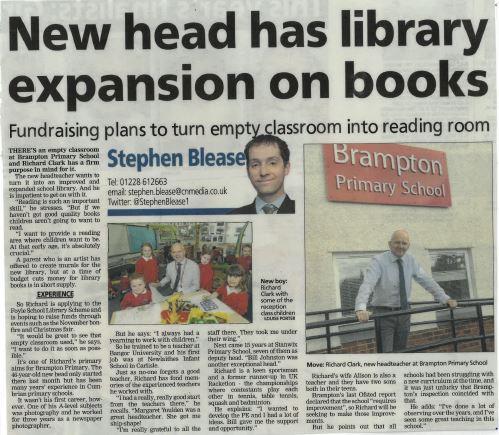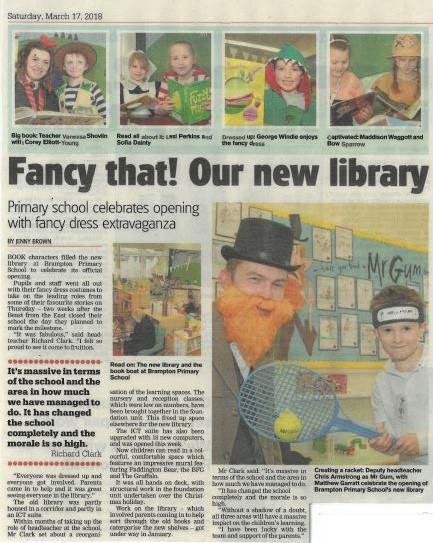English
Intent
The overarching aim for English in the National Curriculum is to promote high standards of language and literacy by equipping pupils with a strong command of the spoken and written word and to develop their love of literature through widespread reading for enjoyment.
At Brampton Primary School, we aim to create a positive reading and writing culture in school, where both are promoted, enjoyed and considered ‘a pleasure’ for all pupils. We want our children to write clearly, accurately and coherently, adapting their language and style in and for a range of contexts, purposes and audiences. We aim to ensure all of our children develop confidence, and a general love of language and of the written word, through a text-based approach, as the text we are using in our writing lessons has careful links across the curriculum to ensure that children’s English learning is relevant and meaningful, where possible linking our reading, writing, and the theme that we are covering in our foundation subjects.
Through choosing quality texts, we want pupils to develop a love of reading and a good knowledge of a range of authors, and be able to understand more about the world in which they live, through the knowledge they’ve gained from texts that they listen to, read and use as inspiration for their writing. The school is determined that every pupil will learn to read and make sufficient progress to meet or exceed age-related expectations and when our children leave our school, we expect them to be children who read fluently and widely, and are able to express preferences and opinions about the texts that they read. We want them to read for pleasure, having had access to a wide range of text types, genres and authors in order for them to make informed opinions about their favourites.
We want pupils to acquire a wide vocabulary, a solid understanding of grammar and be able to spell new words by effectively applying the spelling patterns and rules they learn throughout their time in primary school.
We want to inspire children to be confident in the art of speaking and listening and who can use discussion to communicate and further their learning. As a school we are very aware that some of our pupils’ early language acquisition is limited and this is why we believe that providing a language-rich environment, with a strong focus on oracy, is essential to the success of our curriculum.
Implementation
The systematic teaching of phonics has a high priority throughout EYFS and KS1. Phonics is taught daily to all children in the Foundation Stage, Year 1 and those in Year 2 who have not yet reached the threshold of the phonics screen in Year 1. Staff systematically teach learners the relationship between sounds and written spelling patterns, or graphemes, which represent them. Phonics is delivered in a whole class format because it enables staff to ensure that application is there across all subjects, embedding that process also in a rich literacy environment for early readers. Intervention is planned for those children who are working below expected levels.
Read Write Inc is used as the spine for delivery of the phonics sessions. This programme is visual, audial and kinaesthetic, thus increasing the likelihood of rapid progress. Pupils will be given reading books which match closely to the phase of the phonics they are currently working on. This forms the foundation for lifelong readers. All children from Year 1 compete phonics assessments to ensure that they read appropriately challenging books. This is regularly checked and reading book bands changed accordingly. All children in Foundation Stage read individually to a trained adult. Some children will read 1 to 1 with an adult as a form of intervention.
We also want children to develop the habit of reading widely and often, both for pleasure and for information, in the classroom, across the school and at home. Our school regularly invests in new book stock so that a wide variety of appropriate quality texts covering all genres are available in our libraries. From Year 2 upwards, the Accelerated Reader scheme is used in school. This allows children to choose what they read from a range closely matched to their comprehension and to develop discussion of reading habits and preferences. It also facilitates regular teacher assessment and increasing levels of independent reader awareness of progress. All children have classic texts read to them in all year groups; this may include traditional tales and rhymes in EYFS and KS1, right through to classic novels in KS2.
From KS1, children are given a reading record or homework diary which provides a channel of communication between home and school. We expect children to read daily at home for at least ten minutes and for parents to acknowledge their child's efforts. We send regular progress updates in the form of phonics tracking and mid-term reports. In upper KS2, children record their Accelerated Reader quiz results and discuss these both with their teacher and at home. We also hold information sessions and produce resources to provide parents with information regarding KS1 phonics assessments and Year 6 SATs.
We use the Cumbria Library Service to provide a Library Bus Service each term. This provides children with the opportunity to visit a library, discuss authors and genres with an expert in children's literature and select texts based on their preferences. This culture of book recommendations is evident in classrooms and forms part of reading areas in classrooms which display age-appropriate texts.
All children from Reception take part in guided reading sessions. These are planned by teachers to teach a variety of skills and techniques which enable children to comprehend the meaning of what they read and develop understanding of the vocabulary used by authors. From Year 2 upwards, guided reading involves whole class sessions as well as small group work.
Our writing sequences follow a text-based approach. These texts are linked to our foundation subjects wherever possible and reflect our literary heritage and local context. We use Ready Steady Write to plan writing sequences and draw inspiration from our teachers’ knowledge and love of literature when selecting the vehicle texts to use. A text-based approach ensures our children experience and internalise a range of characters, plots and story language that forms a wealth of schema to draw from for their writing and that will carry them through to each new stage of their education.
As children progress through sequences of work, a gradual increase in independence is promoted and expected. High quality teacher modelling and guided instruction will flow in to collaborative learning and eventually, independent work which will demonstrate each child’s progress and development. They will have the opportunity to summarise, draft, edit, revise and share their writing.
Writing is continually monitored in and after lessons, with ongoing feedback provided to the children. Summative assessments are made at the end of each writing unit, with one assessed piece of writing per half term for each child. These help to inform termly assessment points in every year group.
As part of English sequences, children are inspired by drama, experience days, visits and real audiences and purposes for their writing. Children will learn the language and structural features of a range of genres and text types and will be challenged to apply their learning from English lessons to further writing lessons and across the curriculum.
Computing is an important part of the literate environment. It can be used in a number of ways to assist the children with drafting work, enabling them to see the content of their writing clearly and allow them to pick up errors in spelling, punctuation and expression. Many children who find writing physically challenging are often greatly encouraged by using the computer to present their work or communicate meaning. For some children, communication devices and the ability for programs to ‘talk back’ are particularly helpful.
We recognise the importance of spoken language in pupils’ development across the whole curriculum - spoken language underpins the development of reading and writing. Children are encouraged to develop effective communication skills in readiness for later life. Opportunities to develop these skills include debating, class assemblies and presentations, talk partners, drama and in yearly productions, for example. All of these speaking and listening skills are taught in Literacy, across the curriculum and during extra-curricular activities too.
Impact
The impact of our English curriculum is measured through the monitoring cycle in school.
We use NFER and previous SAT papers to assess reading and spelling, punctuation and grammar. These standardised termly tests are used to measure and predict progress against the national curriculum, tailored not just to the year group but coverage of the curriculum expected at each assessment point during the year. We also use the Accelerated Reader programme to assess reading termly from Year 2. This produces reports detailing reading age, fluency levels and competencies in specific reading skills. It then allows for specific and timely interventions to be planned and carried out.
Early reading is assessed regularly and tracked using phonics tracker. This then allows teachers to tailor homework, identify gaps and plan interventions. Regular training, observations, staff meetings and book looks ensures quality phonics teaching and learning.
In writing, children are assessed primarily with reference to the independent writing they complete during the schemes of work. This is usually a showcase of their skills towards the end of a teaching sequence. The quality of writing in English and curriculum books is evaluated by learning walks, observations, pupil conferencing and work scrutinies. Teachers moderate pupils’ work in school and also work in partnership with our cluster schools to ensure accurate assessments are made.
Data is then used to analyse gaps in children’s knowledge and gain an overview of specific groups of children across school. This informs future areas for improvement and the impact of new initiatives. The English subject leader provides an action plan for the subject and addresses areas for development and improvement which is then shared with all staff and link governors.
At Brampton Primary School, the impact of the reading and writing curriculum is felt inside and outside of the classroom. You will see evidence of our reading and writing culture in our school entrance, corridor displays, teacher conversations, reading corners and newsletters. Our library is well-used and contains a range of fiction and non-fictions books for children to enjoy.
We have realised a community of enthusiastic writers who love showcasing their developing literacy knowledge and skills. Children take pride in the presentation, content and impact of their writing. Outcomes of work in both Literacy and Topic books evidence the high quality of work and the impact of varied and cross-curricular writing opportunities. These enable children to write across a range of forms and to adapt their writing successfully, considering purpose.
We believe our curriculum prepares learners for the next steps in their learning journeys. It leads them to become informed, enthusiastic and skilled as readers and writers who can engage with texts and the world around them as reflective and independent thinkers. Through discussion and feedback, children talk enthusiastically about reading and writing and understand the importance of this subject. They can also talk about books and authors that they have enjoyed and can make reading recommendations.
Read Write Inc Parents Info This is the official Read Write Inc website for parents.
News!
|
|
|
|



